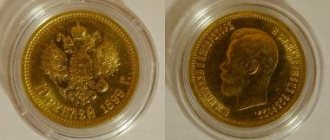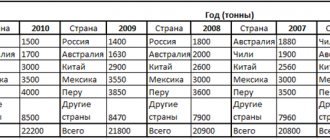The gold standard as a system emerged in the mid-19th century. The emergence of this system was caused by the need to establish trade settlements between the industrial capitals of large countries.
The gold standard was based on the following principles:
- Each currency was guaranteed to be convertible into gold within the country and beyond its borders. This means that banknotes in the form of coins and banknotes could be freely converted into gold and back by the issuing institution;
- Such a system presupposed the strict maintenance of a given ratio between national gold reserves and the total amount of state money. By the way, what Russia’s gold reserves are now can be found out in the article “Gold reserves of the countries of the world”;
- The exchange rate was determined by the content of each monetary unit in gold;
- International payments based on the gold standard were characterized by high stability of exchange rates and compliance with the state's balance of payments.
Thus, the introduction of the gold standard system had a very positive impact on the development of all world trade. The gold standard ensured small fluctuations in exchange rates and became the key to the balance of international transactions.
However, with the advent of World War I, the gold standard lost its former effectiveness. This is due to the fact that high military costs forced countries to take loans from their central banks, while forced exchange rates were established, which, accordingly, suspended the convertibility of the currencies of the warring countries into gold.
This state of affairs was fundamentally contrary to the basic principles of the established financial system. Therefore, after the end of hostilities of the First World War, the gold standard actually ceased to exist, as well as the 583 standard for gold, which is not used in the jewelry industry.
The birth of the gold exchange standard
The gold exchange standard is a system that provides for the possibility of exchanging banknotes for the mottos of countries that back their currencies with gold.
In countries that took part in the hostilities of the First World War, significant changes occurred in the ratio of gold reserves and the total money supply. This caused an unprecedented increase in inflation. It was under these conditions that the gold exchange standard was born.
The gold exchange standard provided for the possibility of exchanging banknotes not for gold itself, but for banknotes of other countries (mottos), which could then be converted into gold.
The main mottos at that time were the English pound sterling and the American dollar. However, gold retained its status as a legitimate international currency. The gold exchange standard was legislated at the Genoa Conference in 1922.
The war caused a split in the core of the gold bloc countries. Investors began to massively transfer their savings into pounds sterling, this phenomenon caused a payments imbalance. This necessitated the need for extremely strict currency control in Great Britain and its deferment of domestic and international payments.
Current situation
After it became clear that the gold exchange standard did not solve the problem, but only postponed it for a not too long period, it was decided to abandon settlements in gold altogether. Almost all the world's leading countries agreed with this at various times; the rest were simply presented with a fait accompli. Now currency prices are floating, depending on such a huge number of factors that even a professional with a very long experience in this field cannot always predict where the rate will swing.
The situation is similar now with the cost of various goods. If previously the price for them was formed on the basis of the total costs of creation, transportation, storage, wages, and so on, now all these indicators are rather secondary in nature. And the principle of how much they are willing to pay for a given product came first. In fact, the cost of most of any modern product is not worth even a tenth of the money that is asked for it. But as long as there are people willing to pay the requested amounts for these goods, the situation will not change.
Transition to floating rates
The convertibility of the British pound sterling did not stop with the outbreak of hostilities in the First World War, at least in legal terms. However, the Bank of England began to put pressure on market players and introduced new regulatory measures. This was practically tantamount to abandoning the fixed exchange rate. Gold imports went directly into the Bank of England's reserves, and its exports were limited.
England was just the first sign. Almost all countries of the gold bloc followed its example and introduced it in 1914-1915. similar measures. The United States of America entered the war much later than the European countries, this is due to the fact that the introduction of restrictions on the convertibility of the dollar was introduced only in 1917. True, an unofficial ban on the export of gold was imposed by New York banks already in 1914. The result of the introduction of widespread restrictions on the convertibility of currencies was the emergence of floating rates.
After the hostilities died down, the world community made an attempt to return to its former stability. Such an attempt implied a gradual return to the monetary standard. Initially, with the help of currency interventions, the central banks of the participating countries were supposed to stabilize the exchange rate of the national currency.
After which it was necessary to introduce deflationary policies in order to restore pre-war parity. Many countries around the world have followed this pattern to achieve stability. The gold standard regained its stability by 1928, but its existence lasted only until the start of the Great Depression.
After World War I, the international community made another attempt to return to lost stability. The laws of gold monometallism assumed a gradual return to the gold standard. Initially, central banks, using foreign exchange interventions, were supposed to stabilize the exchange rate of their national currency.
At the next stage, in order to quickly restore the lost parity, they needed to implement a deflationary policy. Many countries followed the classical scheme. By 1928, the international monetary system had finally achieved long-awaited stability, but its existence lasted only until the onset of the Great Depression.
The function and importance of gold currency in the country's economy
The main task that the gold-based settlement system solved was the creation of a fixed exchange rate. As a result, conditional equality was established in settlements at the international level. Transactions were simplified and all participants were given more confidence.
Gold bars
A feature of the monetary system of that time was the unimpeded import and export of the yellow precious metal. But to maintain its functioning, it was necessary to set the exchange rate of the national currency within the country so that it would be possible to exchange banknotes for gold. The further abolition of this system by one state (for example, the country that set the global direction of politics in those days) gradually led to the fact that others abandoned this method of calculation.
There was parity and the concept of “golden points”, which made it possible to control the deviation of the currency exchange rate from the introduced standard. The error allowed was no more than +/-1%.
When it comes to conversion, you need to remember that in the days of payment using gold money it was possible to convert bars and banknotes into coins. This limited the state's ability to issue bullion. They could only be made taking into account the country's gold reserves.
Differences from the classical system
The interwar gold standard had several important characteristics that distinguished it from the classical monometallic system.
At this time, the gold standard became widespread among countries around the globe, including the leaders of world industry. However, there were a number of countries, including Russia, that either never introduced the gold standard on their territory or left it.
The configuration of national currency systems has changed significantly. Some countries restored the convertibility of their currencies at pre-war parity, which corresponded to classical norms. But many countries decided to devalue their currencies, fixing a new, unjustified exchange rate. The countries that were part of the German-Austrian coalition experienced an explosion of hyperinflation, and they had to introduce new currencies into circulation.
Some countries that gained independence only after the First World War rushed to join countries for which the gold standard was the norm. Latin American countries began the transition from the bimetallic and silver standards to the gold standard. And finally, many Asian states and post-revolutionary Russia in general either left the gold standard or never participated in it.
The bloc of countries that adhered to the gold standard acquired extreme heterogeneity. At the same time, there were three forms of the gold standard. At the same time, the gold coin standard became less widespread in the interwar period.
For example, France and Great Britain switched to the gold bullion standard, America retained the gold coin standard, and in Germany a gold exchange standard was introduced.
Types of gold standard
Going to the gold standard primarily meant using some collateral to increase the value of the currency. In most cases, they involve the use of yellow precious metal. However, there were other versions of the gold standard.
Gold bars
Monetary
The gold coin method of calculation according to this scheme is based on the use of coins made of precious metals. Previously, at some point, gold and silver money remained in use. Then the concept of “bimetallic means of payment” appeared. Their different types were used to conduct trade transactions of various sizes: large, small. According to the occasion, coins of a certain type were used. Each variety has its own disadvantages:
- small ones (pennies, farthings) were quickly lost;
- large gold coins, which also contained base metals, were of lower value, the metal had different properties when compared with pure gold, so fakes often appeared;
- Silver coins of large denomination were large in size, which created discomfort during their transfer and use.
Later it was decided to switch to one of the metals. This is how monometallism appeared. It provided for the possibility of using only gold or only silver. This is a simpler method of payment, but the choice of any one system limited the functions of the means of payment. This is due to the difference in the price of precious metals.
Ingot
The introduced system involves the redemption of funds not for coins, but for bars. The calculation principle remains the same as in the case of the monetary option. Moreover, the system was introduced approximately 100 years later in Great Britain. Considering that it helped reduce the cost of maintaining the payment system, there was no rush to abandon the gold bullion option. Another advantage was the ability to remove gold from circulation and use it only for its intended purpose within the country. Coins were replaced by tokens that perform the same function.
Beginning of the dollar era
The gold standard increasingly leaned towards a bicurrency system, which was based on the US dollar and the British pound sterling. Even before the end of the First World War, the transition to a new system was completed, which implied two types of reserve assets.
By the end of the war, price levels were approximately double their pre-war levels. At the same time, gold production decreased, and leading countries refused to revalue the metal, which reduced the overall supply. The result was the beginning of a search for funds that would help avoid a gold shortage.
The Genoa Conference adopted several resolutions on currencies. It was allowed to use a gold exchange standard, this would help save metal reserves.
Before the war, gold bloc countries only stored gold in the form of coins. The exception was the Reichsbank of Germany, which kept 13% of its reserves in foreign currencies. By 1928 All other countries have introduced this practice.
After the war, the position of the British currency strengthened significantly. The second place in pop popularity was taken by the American dollar, after the war its share increased 10 times.
Gold standard currencies: ruble, dollar, euro
The established rules for pegging currencies to the dollar after the abolition of the settlement scheme using gold money were in effect for a long time. Since then, these means of payment have constantly strengthened their positions and become widespread. A similar system exists today in Europe - the currencies of 18 countries are pegged to the euro. The ruble also has no connection to the yellow metal. Even if the gold reserves are transferred to a reserve to back the national currency, its quantity will not be enough to create the basis for increasing the value of the ruble.
Dollars, rubles and euros
Gold coin standard
Gold coin standard
Monometallism is a monetary system in which one monetary metal (gold or silver) serves as a universal equivalent and at the same time in circulation there are other signs of value (banknotes, treasury notes, change coins) exchanged for this monetary metal (gold or silver).
Gold monometallism was first established in Great Britain actually at the end of the 18th century, legislatively in 1816; and in the last third of the 19th century. Most countries switched to a gold-based monometallic monetary system. Gold monometallism was introduced in Germany in 1871-1873, in Sweden, Norway and Denmark in 1873, in France in 1876-1878, in Austria in 1892, in Russia and Japan in 1897 g., in the USA - in 1900.
The gold coin standard, which is conventionally called the classical gold standard, existed in countries whose monetary system was based on gold coins, that is, coins minted from gold. At the same time, paper money was also issued. Any owner of a banknote could exchange paper money at the bank for gold coins or gold bars according to the established guaranteed parity, which was fixed on the banknotes themselves.
The gold coin standard, based on the official recognition of the use of gold as the only monetary commodity and a universal measure of value, assumed:
-free minting of full-fledged gold coins for any owner; — their actual circulation in internal circulation; ——————unlimited exchange of monetary substitutes, including paper money, for metal at fixed parities with the unhindered export of gold from the country and its import from abroad.
Gold monometallism existed before the First World War (1914-1918) in the form of a gold coin standard. The gold coin standard is characterized by the fact that the prices of goods are calculated in gold; in the internal circulation of the country there are full-fledged gold coins, gold performs all the functions of money; free minting of gold coins is carried out for individuals with a fixed gold content; banknotes in circulation (banknotes, metal coins) can be freely and unlimitedly exchanged for gold coins at nominal value (for example, in Russia a 5-ruble credit card was exchanged for 5 rubles in gold); free export and import of gold and the functioning of free gold markets are allowed.
All this ensured the relative stability and elasticity of the monetary system. Gold coins that were excessive in comparison with the requirements of the law of monetary circulation went out of circulation and became treasures. With the expansion of the economic need for money, gold came from the treasure into circulation. Therefore, the gold coin standard best met the requirements of the national economy and contributed to the development of production, the credit system, international trade and credit, and the export of capital.
At the same time, the functioning of the gold coin standard required the presence of certain gold reserves at central banks, which served as a reserve of coin circulation and ensured the exchange of banknotes for gold.
It should be noted that even during the heyday of the gold coin standard, the exchange of banknotes for gold was often suspended during periods of war, when the state was forced to finance military expenses through paper issues. This was the case in Great Britain during the Napoleonic Wars, and in America during the Civil War of 1861-1865. The First World War, which required large financial expenditures for military needs, caused an increase in the budget deficit of the warring states and led to the abolition of the gold coin standard. In all warring countries (except the USA), the exchange of coins for gold was stopped and its export abroad was prohibited; gold coins went out of circulation into treasure. After World War I, not a single developed country was able to return to the gold coin standard. In the conditions of post-war economic stabilization in the 1920s, a gold bullion standard was established in a number of countries. Under the gold bullion standard, unlike the gold coin standard, there are no gold coins in circulation and their free minting. The exchange of banknotes and other inferior money was carried out only for gold bars weighing about 12.5 kg, which required presenting a fairly large amount of money to the bank. In most countries, the direct exchange of inferior money for gold was not restored even in this form, but the exchange of credit money for foreign currency (mottos), the so-called gold and foreign exchange (gold exchange) standard, was used. Under the gold exchange standard, there is also no free circulation of gold coins and free minting. The exchange of inferior money for gold is carried out using an exchange for the currencies of countries with a gold bullion standard. In this way, the indirect connection between the monetary units of countries with a gold exchange standard and gold was maintained.
It is characteristic that even at the height of the triumph of the gold coin standard, international payments were carried out mainly using drafts (bills of exchange) issued in national currency, mainly in English. Gold has long served only to pay for the passive balance of the country's international accounts. Since the end of the 19th century. There was also a tendency towards a decrease in the share of gold in the money supply (in the USA, France, Great Britain from 28% in 1872 to 10% in 1913) and in official reserves (from 94% in 1880 to 80% in 1913 .). Exchangeable credit money replaced gold. The regulatory mechanism of the gold coin standard ceased to operate during economic crises (1825, 1836-1839, 1847, 1857, 1855, etc.). The regulation of the exchange rate through deflationary policies, lower prices and increased unemployment turned against workers, giving rise to social dramas.
Under the gold coin standard, the prices of all goods were calculated in gold, and gold coins circulated freely. Any owner of gold bullion or jewelry had the unlimited right to mint gold coins from the metal at the state mint. There was a free exchange of banknotes for gold at face value. There were no restrictions on the import of gold into the country and its export abroad.
The gold coin standard was the most stable monetary system that met the needs of developing capitalism during the period of free competition. He ruled out inflation as excess notes were turned into gold and out of circulation. The gold coin standard was based on the gold content of each national currency. It was announced by the government, which guaranteed the unhindered exchange of banknotes for gold.
During the period of the gold coin standard, the national and international monetary systems were identical, with the only difference being that the coins of a given country were shed, in the words of K. Marx, “national uniforms” and in the form of bars passed into international payment circulation, and then, after reminting, they again served internal monetary circulation.
Thus, the nature of money is such that it is exchanged for goods and services (markets for goods and services), for the currencies of foreign countries (foreign exchange market), for gold (gold market) or for credit documents and securities certifying equity participation in assets and profits of a particular company (capital market).
The collapse of the gold coin standard also led to a reduction in the issue of bank silver coins. The last silver ruble was minted in 1915 and has numismatic value. True, until the fall of the House of Romanov, the minting of low-grade silver coins continued, but in increasingly limited quantities. Money circulation became almost entirely paper. The stability of the ruble has sharply decreased. Under these conditions, processes developed that initially led the ruble to rampant inflation, and then brought the entire monetary economy to the brink of collapse











